A Novel Approach for the Automatic Estimation of the Ciliated Cell Beating Frequency
Abstract
:1. Introduction
2. Materials and Methods
2.1. Sample Collection and Preparation
- Video background noise level, for which we marked three noise levels, as shown in Figure 1;
- The presence of single or multiple cells in a single frame;
- In-place movement of the cell body, which may affect the automatic estimation of the CBF. We labeled this as “weak” if the cell body was almost immotile, “discrete” (resp. “high”, “very high”) if it was slightly (resp. highly, very highly) vibrating in-place.
2.2. BeatCilia System Description
- Cell RoI detection, devoted to the detection of regions of interest, i.e., small portions of the image that depict the cilia or the whole cell area;
- Cell body masking, which acts as a fine-tuning step for each of the RoIs detected in the previous step. The aim is to highlight only cilia, explicitly excluding pixels belonging to the cell body;
- CBF estimation, aimed at measuring the beating frequency for each automatically detected ciliated cell.
2.2.1. Cell RoI Detection
- Grayscale conversion and equalization using the Contrast Limited Adaptive Histogram Equalization (CLAHE) algorithm [44] to enhance the contrast and sharpness;
- Dense optical flow computation;
- Optical flow magnitude thresholding and morphological filtering;
- RoI detection.
2.2.2. Cell Body Masking
- The darkness of the basal body, a streak where cilia are anchored to, which marks the boundary between cilia and the cell body;
- A strong white glow that surrounds the cytoplasm and stops right below the dark basal body, a visual effect due to the presence of the cell body, which has its own thickness.
2.2.3. CBF Estimation
3. Experiments and Results
- The first experiment was a preliminary test of the proposed method. It was run on ad-hoc video simulations, which reproduced a constant beating pattern;
- The second experiment run on the videos included in our dataset was performed to validate the approach in a real case scenario;
- Finally, we compared the execution times of BeatCilia running on multiple platforms (including a smartphone) and showed our results compared to those achieved by a couple of previous studies (only partially compatible with our system, as they did not use the same facilities).
- i stands for the required pixel intensity assigned to the square patch;
- f is the square patch frequency, in hertz;
- t represents the time (in seconds), in our experiment ranging from 0 to N.
- Testing the effectiveness of the cell RoI detection;
- Testing the cell body masking;
- comparing BeatCilia results with the ground truth.
- The number of pyramid layers = 3;
- The size of each layer = 0.5;
- Number of computing iterations = 3;
- The size of the pixel neighborhood = 5;
- The averaging filter size = 15.
- Platform: Shows the platforms on which the system is available;
- Frame size: The size of the processed video frames; (*) authors do not specify the resolution they used;
- Elapsed time per frame: Average time (in seconds) required to process a single frame. For BeatCilia, we chose the worst case, represented by cilia 10. For [38], the value was computed from the total running time declared in the paper. Here, [34] is marked as not available because the authors declare a running time of “minutes”;
- Wide microscopic field: Shows whether the system can process wide microscopic field images or if it requires that the scene is manually zoomed on a single ciliated beating cilia;
- Single- or multiple-cell CBF: Whether the system is capable to estimate CBF for multiple cells in the scene;
- RoI selection method: Whether the system requires manual interaction to select RoIs or to set any parameter.
4. Conclusions and Future Works
Author Contributions
Funding
Conflicts of Interest
Appendix A. The Ciliated Epithelium
References
- Dimauro, G.; Caivano, D.; Bevilacqua, V.; Girardi, F.; Napoletano, V. VoxTester, software for digital evaluation of speech changes in Parkinson disease. In Proceedings of the 2016 IEEE International Symposium on Medical Measurements and Applications, MeMeA 2016, Benevento, Italy, 15−18 May 2016. [Google Scholar] [CrossRef]
- Bevilacqua, V.; Brunetti, A.; Trotta, G.F.; Dimauro, G.; Elez, K.; Alberotanza, V.; Scardapane, A. A Novel Approach for Hepatocellular Carcinoma Detection and Classification Based on Triphasic CT Protocol. In Proceedings of the IEEE Congress on Evolutionary Computation 2017, San Sebastian, Spain, 5−8 June 2017. [Google Scholar] [CrossRef]
- Dimauro, G.; di Nicola, V.; Bevilacqua, V.; Caivano, D.; Girardi, F. Assessment of Speech Intelligibility in Parkinson’s Disease Using a Speech-To-Text System. IEEE Access 2017, 5. [Google Scholar] [CrossRef]
- Rubaiat, S.Y.; Rahman, M.M.; Hasan, M.K. Important Feature Selection & Accuracy Comparisons of Different Machine Learning Models for Early Diabetes Detection. In Proceedings of the 2018 International Conference on Innovation in Engineering and Technology (ICIET), Dhaka, Bangladesh, 27−28 December 2018; pp. 1–6. [Google Scholar] [CrossRef]
- Dimauro, G.; Caivano, D.; Girardi, F. A New Method and a Non-Invasive Device to Estimate Anemia Based on Digital Images of the Conjunctiva. IEEE Access 2018, 6, 46968–46975. [Google Scholar] [CrossRef]
- Dimauro, G.; Baldari, L.; Caivano, D.; Colucci, G.; Girardi, F. Automatic Segmentation of Relevant Sections of the Conjunctiva for Non-Invasive Anemia Detection. In Proceedings of the 3rd International Conference on Smart and Sustainable Technologies (SpliTech 2018), Split, Croatia, 26–29 June 2018; ISBN 978-953290083-5. [Google Scholar]
- Hasan, M.K.; Aziz, M.H.; Zarif, M.I.I.; Hasan, M.; Hashem, M.M.A.; Guha, S.; Love, R. HeLP ME: Recommendations for Non-invasive Hemoglobin Level Prediction in Mobile-phone Environment. JMIR mHealth uHealth 2020. [Google Scholar] [CrossRef]
- Dimauro, G.; Impedovo, S.; Pirlo, G.; Salzo, A. RNS architectures for the implementation of the ‘diagonal function. Inf. Process. Lett. 2000, 73, 189–198. [Google Scholar] [CrossRef]
- Dimauro, G.; Impedovo, S.; Modugno, R.; Pirlo, G.; Stefanelli, R. Residue-to-binary conversion by the “quotient function”. IEEE Trans. Circuits Syst. II Analog Digit. Signal Process. 2003, 50, 488–493. [Google Scholar] [CrossRef]
- Valueva, M.; Valuev, G.; Semyonova, N.; Lyakhov, P.; Chervyakov, N.; Kaplun, D.; Bogaevskiy, D. Construction of Residue Number System Using Hardware Efficient Diagonal Function. Electronics 2019, 8, 694. [Google Scholar] [CrossRef] [Green Version]
- Reno, V.; Dimauro, G.; Labate, G.; Stella, E.; Fanizza, C.; Cipriano, G.; Carlucci, R.; Maglietta, R. A SIFT-based software system for the photo- identification of the Risso’s dolphin. Ecol. Inform. 2019, 50, 95–101. [Google Scholar] [CrossRef]
- Maglietta, R.; Bruno, A.; Reno, V.; Dimauro, G.; Stella, E.; Fanizza, C.; Bellomo, S.; Cipriano, G.; Tursi, A.; Carlucci, R. The promise of machine learning in the Risso’s dolphin Grampus griseus photo- identification. In Proceedings of the IEEE International Workshop on Metrology for the Sea, Bari, Italy, 8–10 October 2018. [Google Scholar] [CrossRef]
- Maglietta, R.; Milella, A.; Caccia, M.; Bruzzone, G. A vision-based system for robotic inspection of marine vessels. Signal Image Video Process. 2018, 3, 471–478. [Google Scholar] [CrossRef]
- Maglietta, R.; Reno, V.; Cipriano, G.; Fanizza, C.; Milella, A.; Stella, E.; Carlucci, R. DolFin: An innovative digital platform for studying Risso’s dolphins in the Northern Ionian Sea (North-eastern Central Mediterranean). Sci. Rep. 2018, 8, 17185. [Google Scholar] [CrossRef]
- Bevilacqua, V.; Dimauro, G.; Marino, F.; Brunetti, A.; Cassano, F.; Di Maio, A.; Nasca, E.; Trotta, G.F.; Girardi, F.; Ostuni, A.; et al. A novel approach to evaluate blood parameters using computer vision techniques. In Proceedings of the 2016 IEEE International Symposium on Medical Measurements and Applications (MeMeA), Benevento, Italy, 15–18 May 2016. [Google Scholar] [CrossRef]
- Maglietta, R.; Renò, V.; Caccioppoli, R.; Seller, E.; Bellomo, S.; Santacesaria, F.C.; Colella, R.; Cipriano, G.; Stella, E.; Hartman, K.; et al. Convolutional Neural Networks for Risso’s dolphins identification. IEEE Access 2020. In Press. [Google Scholar] [CrossRef]
- Renò, V.; Losapio, G.; Forenza, F.; Politi, T.; Stella, E.; Fanizza, C.; Hartman, K.; Carlucci, R.; Dimauro, G.; Maglietta, R. Combined Color Semantics and Deep Learning for the Automatic Detection of Dolphin Dorsal Fins. Electronics 2020, 9, 758. [Google Scholar] [CrossRef]
- Maglietta, R.; Amoroso, N.; Bruno, S.; Chincarini, A.; Frisoni, G.; Inglese, P.; Tangaro, S.; Tateo, A.; Bellotti, R. Random Forest Classification for Hippocampal Segmentation in 3D MR Images. In Proceedings of the 2013 12th International Conference on Machine Learning and Applications, Miami, FL, USA, 4–7 December 2013; pp. 264–267. [Google Scholar] [CrossRef]
- Maglietta, R.; Amoroso, N.; Boccardi, M.; Bruno, S.; Chincarini, A.; Frisoni, G.B.; Inglese, P.; Redolfi, A.; Tangaro, S.; Tateo, A.; et al. The Alzheimer Disease Neuroimaging Initiative Automated hippocampal segmentation in 3D MRI using random undersampling with boosting algorithm. Pattern Anal. Appl. 2016, 19, 579–591. [Google Scholar] [CrossRef] [PubMed] [Green Version]
- Gelardi, M. Atlas of Nasal Cytology for the Differential Diagnosis of Nasal Diseases; Edi Ermes: Milan, Italy, 2012; ISBN 9781467530354. [Google Scholar]
- Gelardi, M.; Iannuzzi, L.; Quaranta, N.; Landi, M.; Passalacqua, G. Nasal cytology—Pratical aspects and clinical relevance. Clin. Exp. Allergy 2016, 46, 785–792. [Google Scholar] [CrossRef] [PubMed]
- Gelardi, M. Citologia Nasale. Available online: http://www.citologianasale.eu/citologia.htm (accessed on 12 June 2020).
- Dimauro, G.; Girardi, F.; Gelardi, M.; Bevilacqua, V.; Caivano, D. Rhino-Cyt: A System for Supporting the Rhinologist in the Analysis of Nasal Cytology. In Proceedings of the 14th Intelligent Computing Theories and Application, Wuhan, China, 15–18 August 2018. [Google Scholar] [CrossRef]
- Dimauro, G.; Ciprandi, G.; Deperte, F.; Girardi, F.; Ladisa, E.; Latrofa, S.; Gelardi, M. Nasal cytology with deep learning techniques. Int. J. Med. Inform. 2019. [Google Scholar] [CrossRef] [PubMed]
- Caruso, G.; Gelardi, M.; Passali, G.C.; de Santi, M.M. Nasal scraping in diagnosing ciliary dyskinesia. Am. J. Rhinol. 2007, 21, 702–705. [Google Scholar] [CrossRef] [PubMed]
- Lemieux, B.; Chen, J.J.; Jing, J.C.; Chen, Z.; Wong, B.J.F. Measurement of ciliary beat frequency using Doppler optical coherence tomography. Int. Forum Allergy Rhinol. 2015, 5, 1048–1054. [Google Scholar] [CrossRef] [Green Version]
- Yager, J.; Chen, T.M.; Dulfano, M.J. Measurement of frequency of ciliary beats of human respiratory epithelium. Chest 1978, 73, 627–633. [Google Scholar] [CrossRef]
- Teichtahl, H.; Wright, P.L.; Kirsner, R.L. Measurement of in vitro ciliary beat frequency: A television-video modification of the transmitted light technique. Med. Biol. Eng. Comput. 1986, 24, 193–196. [Google Scholar] [CrossRef]
- Gray, J. The mechanism of ciliary movement.—VI. Photographic and stroboscopic analysis of ciliary movement. Proc. R. Soc. B Biol. Sci. 1930, 107, 313–332. [Google Scholar]
- Coste, A.; Millepied, M.C.; Chapelin, C.; Reinert, P.; Poron, F.; Boucherat, M.; Escudier, E. Incidence of primary ciliary dyskinesia in children with recurrent respiratory diseases. Ann. Otol. Rhinol. Laryngol. 1997, 106, 854–858. [Google Scholar] [CrossRef]
- Schipor, I.; Palmer, J.N.; Cohen, A.S.; Cohen, N.A. Quantification of ciliary beat frequency in sinonasal epithelial cells using differential interference contrast microscopy and high-speed digital video imaging. Am. J. Rhinol. 2006, 20, 124–127. [Google Scholar] [CrossRef] [PubMed]
- O’Callaghan, C.; Sikand, K.; Chilvers, M.A. Analysis of ependymal ciliary beat pattern and beat frequency using high speed imaging: Comparison with the photomultiplier and photodiode methods. Cilia 2012, 1, 8. [Google Scholar] [CrossRef] [PubMed] [Green Version]
- Sisson, J.H.; Stoner, J.A.; Ammons, B.A.; Wyatt, T.A. All-digital image capture and whole-field analysis of ciliary beat frequency. J. Microsc. 2003, 211, 103–111. [Google Scholar] [CrossRef] [PubMed]
- Chen, J.J.; Lemieux, B.T.; Wong, B.J. A Low-Cost Method of Ciliary Beat Frequency Measurement Using iPhone and MATLAB: Rabbit Study. Otolaryngol. Head Neck Surg. 2016, 155, 252–256. [Google Scholar] [CrossRef] [PubMed]
- Mantovani, G.; Pifferi, M.; Vozzi, G. Automated software for analysis of ciliary beat frequency and metachronal wave orientation in primary ciliary dyskinesia. Eur. Arch. Oto-Rhino-Laryngol. 2010, 267, 897–902. [Google Scholar] [CrossRef] [PubMed]
- Smith, C.; Djakow, J.; Free, R.C.; Djakow, P.; Lonnen, R.; Williams, G.; Pohunek, P.; Hirst, R.A.; Easton, A.J.; Andrew, P.W.; et al. CiliaFA: A research tool for automated, high-throughput measurement of ciliary beat frequency using freely available software. Cilia 2012, 1, 14. [Google Scholar] [CrossRef] [Green Version]
- Kim, W.; Han, T.H.; Kim, H.J.; Park, M.Y.; Kim, K.S.; Park, R.W. An automated measurement of ciliary beating frequency using a combined optical flow and peak detection. Healthc. Inform. Res. 2011, 17, 111–119. [Google Scholar] [CrossRef] [Green Version]
- Puybareau, E.; Talbot, H.; Pelle, G.; Louis, B.; Papon, J.; Coste, A.; Najman, L. A regionalized automated measurement of ciliary beating frequency. In Proceedings of the 2015 IEEE 12th International Symposium on Biomedical Imaging, New York, NY, USA, 16–19 April 2015; pp. 528–531. [Google Scholar]
- Meste, O.; Brau, F.; Guyon, A. Robust estimation of the motile cilia beating frequency. Med. Biol. Eng. Comput. 2015, 53, 1025–1035. [Google Scholar] [CrossRef]
- Dimauro, G. A new image quality metric based on human visual system. In Proceedings of the 2012 IEEE International Conference on Virtual Environments Human-Computer Interfaces and Measurement Systems (VECIMS), Tianjin, China, 2–4 July 2012; pp. 69–73. [Google Scholar] [CrossRef]
- Gigantesco, A.; Giuliani, M. Quality of life in mental health services with a focus on psychiatric rehabilitation practice. Ann. Ist. Super Sanità 2011, 47, 363–372. [Google Scholar] [CrossRef]
- Dimauro, G.; Caivano, D.; Girardi, F.; Ciccone, M.M. The Patient Centered Electronic Multimedia Health Fascicle—EMHF. In Proceedings of the 2014 IEEE Workshop on Biometric Measurements and Systems for Security and Medical Applications (BIOMS), Rome, Italy, 17 October 2014; ISBN 9781479951758. [Google Scholar] [CrossRef]
- Dimauro, G.; Girardi, F.; Caivano, D.; Colizzi, L. Personal Health E-Record Toward an enabling Ambient Assisted Living Technology for communication and information sharing between patients and care providers. In Ambient Assisted Living; Springer: Cham, Switzerland, 2018; ISBN 9783030059200. [Google Scholar] [CrossRef]
- Pizer, S.M.; Amburn, E.P.; Austin, J.D.; Cromartie, R.; Geselowitz, A.; Greer, T.; Romeny, B.M.T.H.; Zimmerman, J.B. Adaptive histogram equalization and its variations. Comput. Vis. Graph. Image Process. 1987, 39, 355–368. [Google Scholar] [CrossRef]
- Farnebäck, G. Two-Frame Motion Estimation Based on Polynomial Expansion. In Proceedings of the Scandinavian Conference on Image Analysis, Halmstad, Sweden, 29 June−2 July 2003. [Google Scholar]
- Alamri, S.S.; Kalyankar, N.V.; Khamitkar, S.D. Image Segmentation by Using Threshold Techniques. arXiv Comput. Vis. Pattern Recognit. 2010. [Google Scholar]
- Brigham, E.O.; Morrow, R.E. The fast Fourier transform. IEEE Spectr. 1967, 4, 63–70. [Google Scholar] [CrossRef]
- Gelardi, M.; Ciprandi, G. Ciliocytophthoria of nasal epithelial cells after viral infection: A sign of suffering cell. Acta Biomed. 2019, 90. [Google Scholar] [CrossRef]
- Gelardi, M.; Cassano, P.; Cassano, M.; Fiorella, M.L. Nasal cytology: Description of a hyperchromatic supranuclear stria as a possible marker for the anatomical and functional integrity of the ciliated cell. Am. J. Rhinol. 2003, 17, 263–268. [Google Scholar] [CrossRef] [PubMed]
- Stanley, P.J.; Wilson, R.; Greenstone, M.A.; Macwilliam, L.; Cole, P.J. Effect of cigarette smoking on nasal mucociliary clearance and ciliary beat frequency. Thorax 1986, 41, 519–523. [Google Scholar] [CrossRef] [PubMed] [Green Version]
- Regnis, J.A.; Robinson, M.; Bailey, D.L.; Cook, P.; Hooper, P.; Chan, H.K.; Gonda, I.; Bautovich, G.; Bye, P.T. Mucociliary clearance in patients with cystic fibrosis and in normal subjects. Am. J. Respir. Crit. Care Med. 1994, 150, 66–71. [Google Scholar] [CrossRef] [PubMed]
- Smaldone, G.C.; Foster, W.M.; O’Riordan, T.G.; Messina, M.S.; Perry, R.J.; Langenback, E.G. Regional impairment of mucociliary clearance in chronic obstructive pulmonary disease. Chest 1993, 103, 1390–1396. [Google Scholar] [CrossRef]

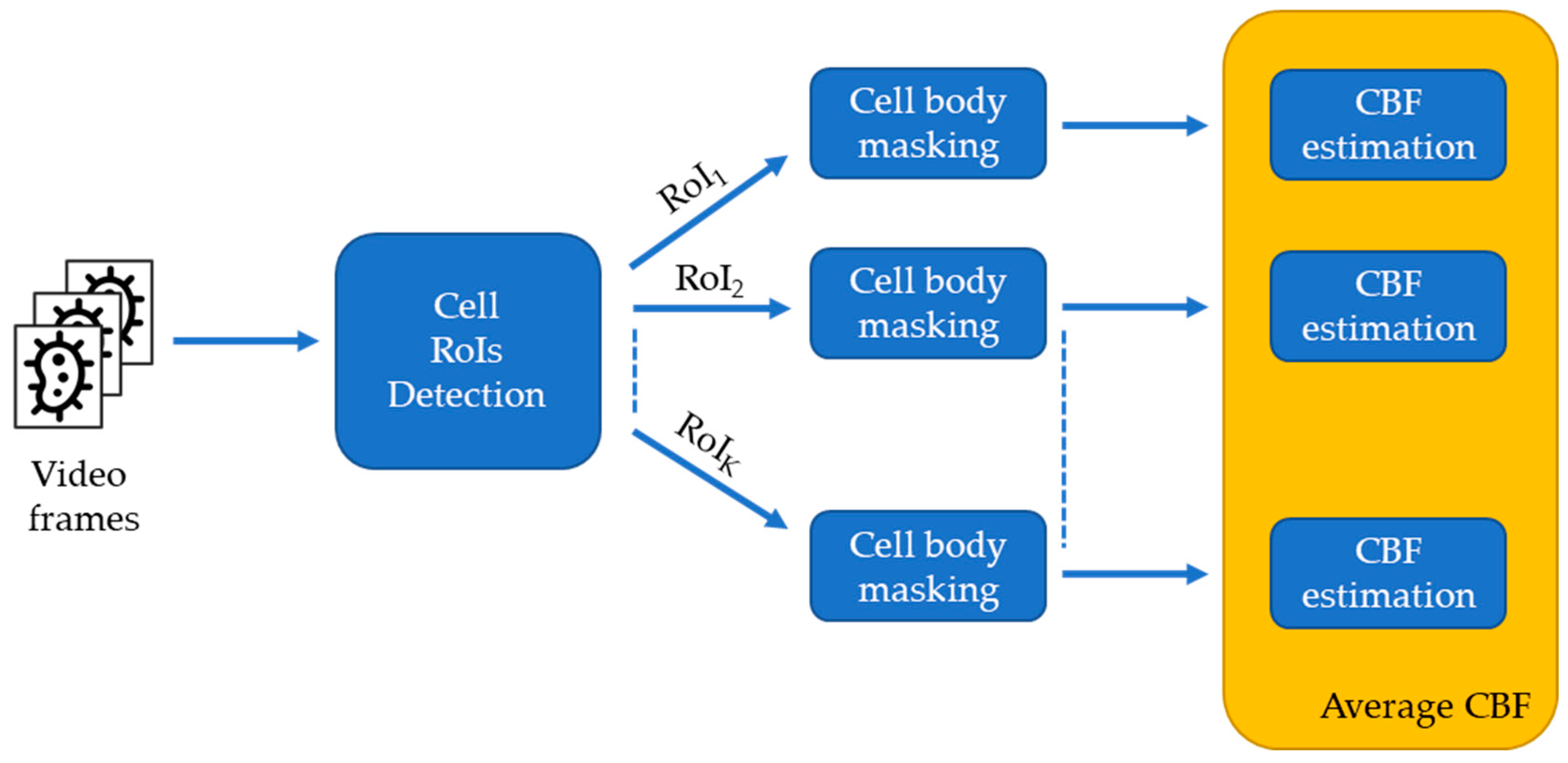




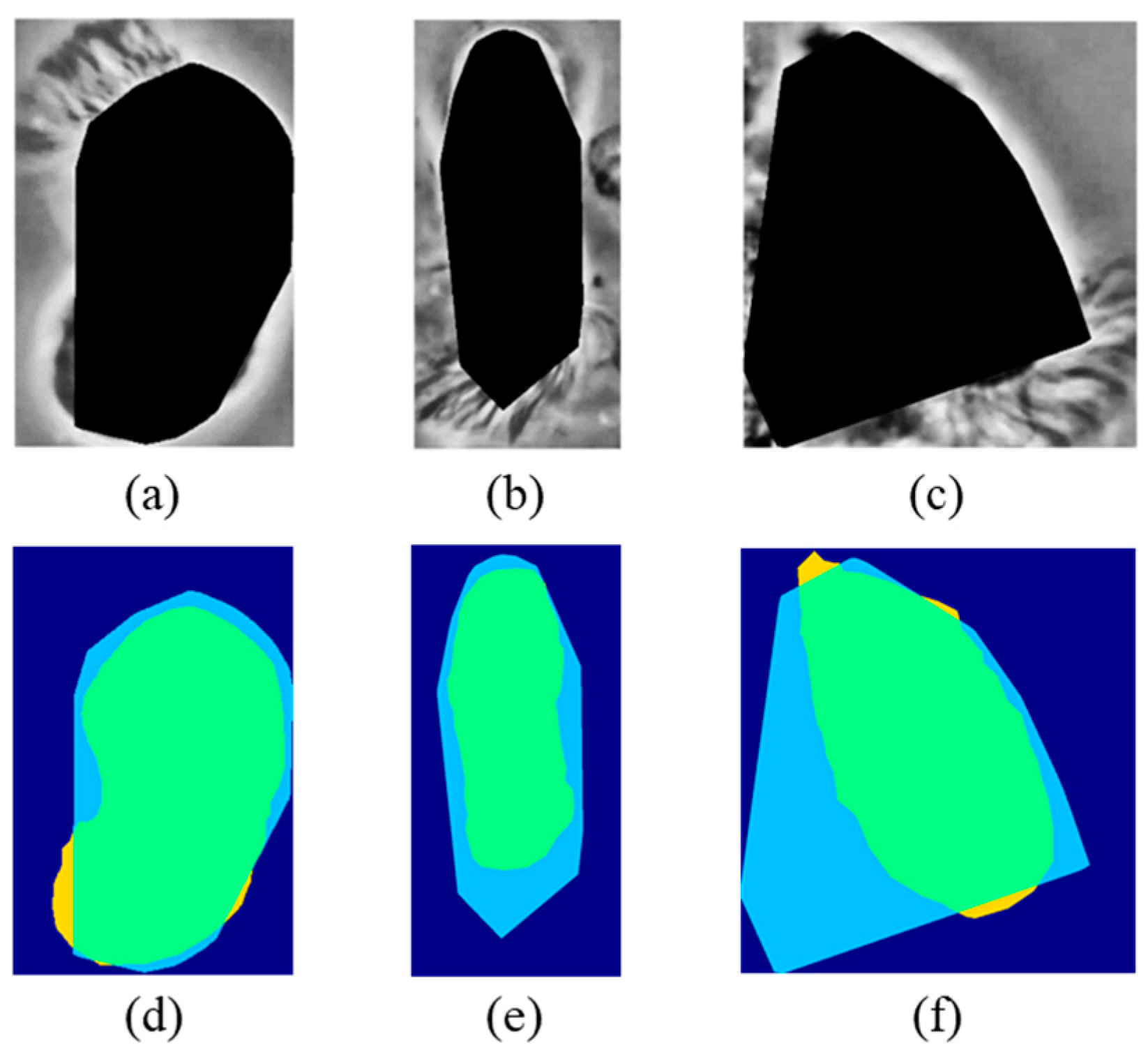
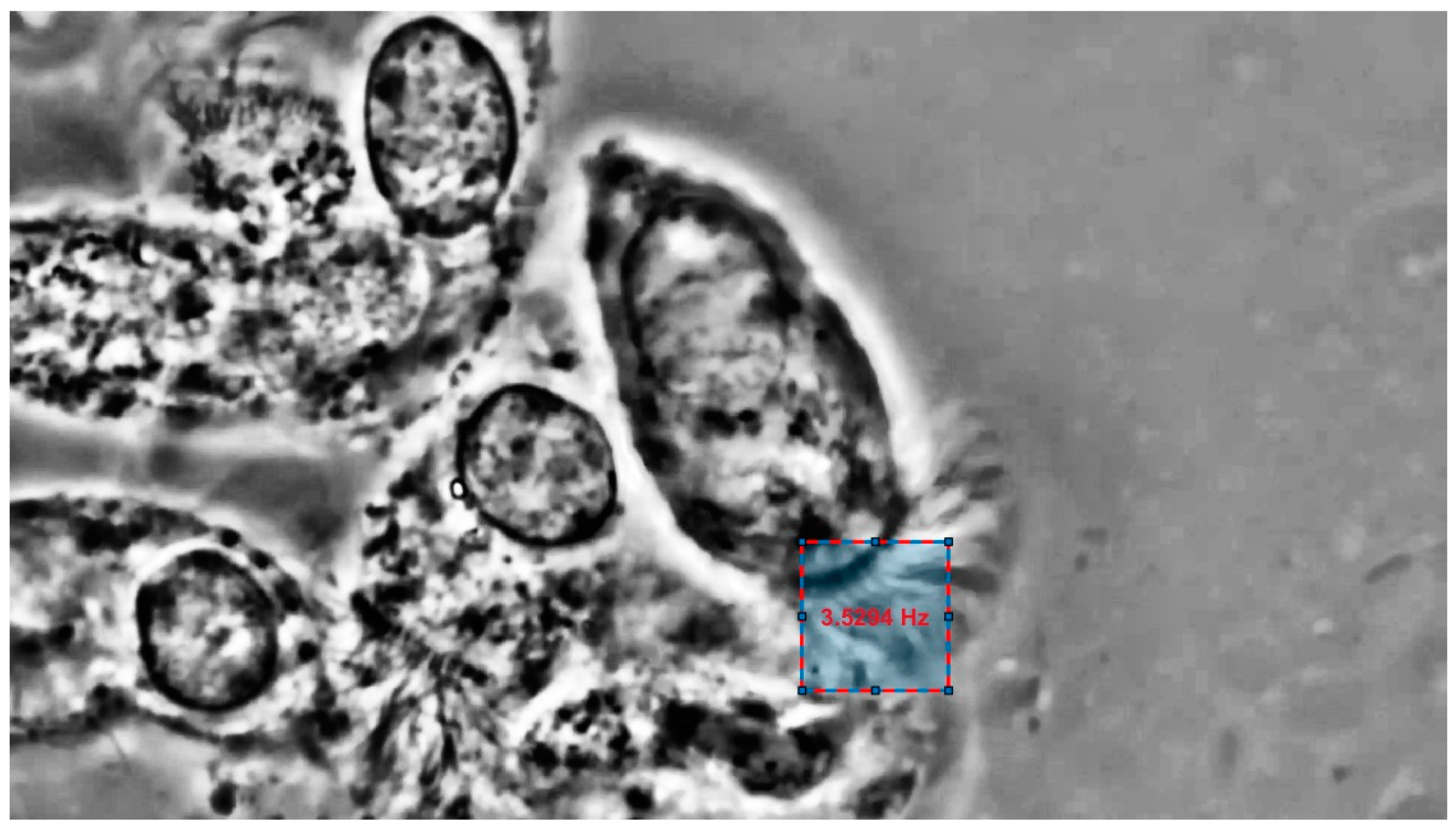
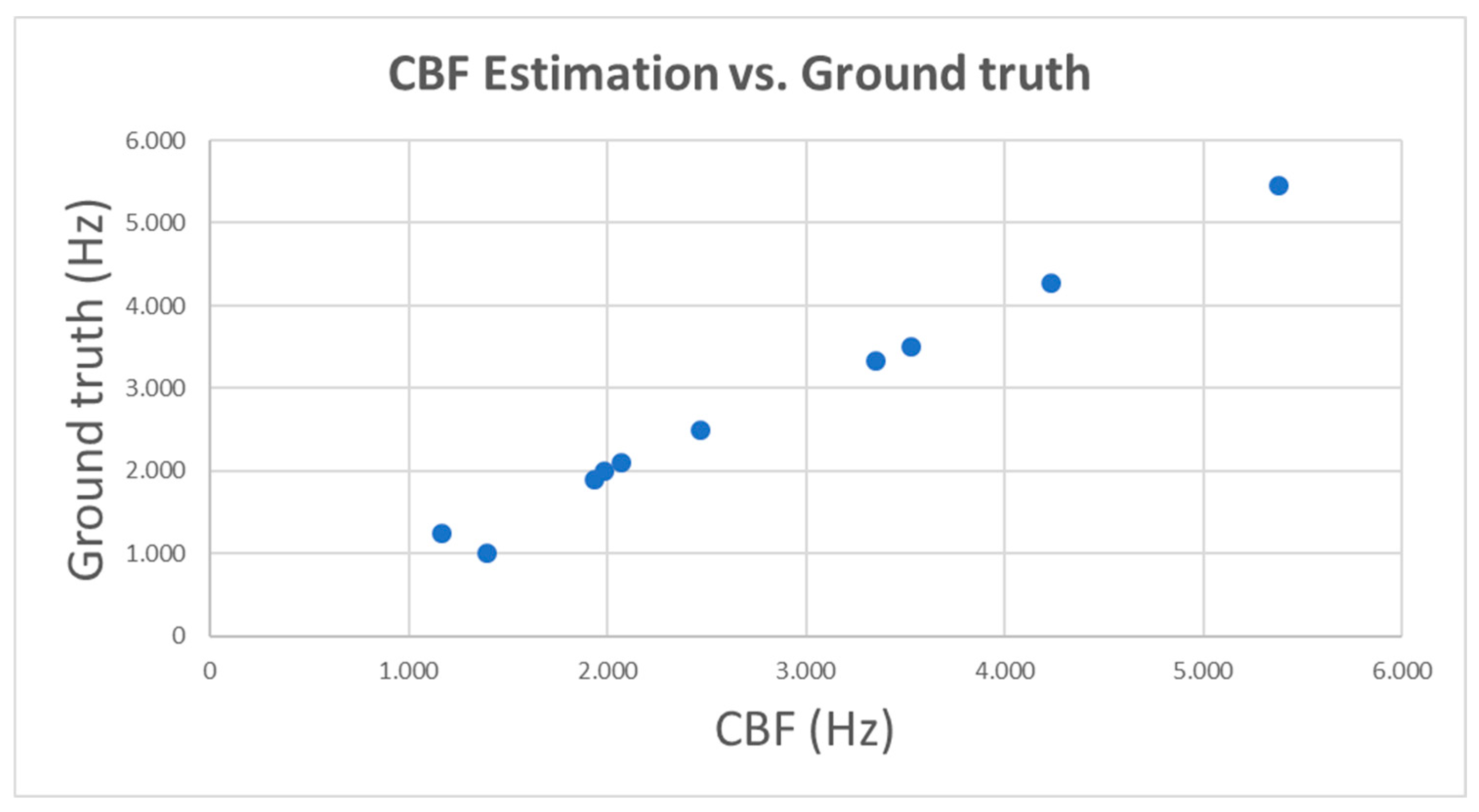
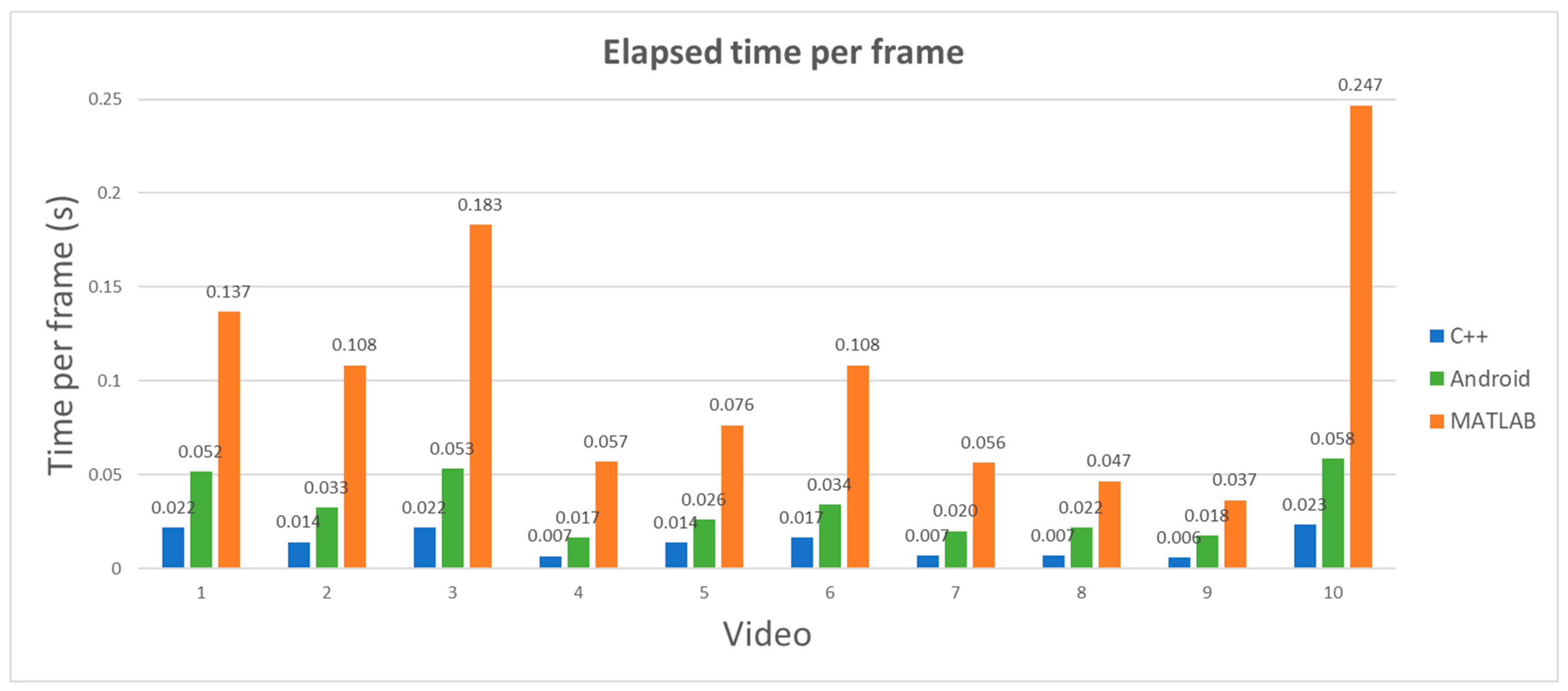
| Name | Duration (s) | Frame Count | Background Noise Level | Cells Presence | Cell Body Movement |
|---|---|---|---|---|---|
| Cilia 1 | 2.9 | 87 | 1 | Single | Weak |
| Cilia 2 | 4.56 | 136 | 1 | Single | Discrete |
| Cilia 3 | 2.88 | 86 | 2 | Single | Discrete |
| Cilia 4 | 2.86 | 85 | 3 | Multiple | High |
| Cilia 5 | 10.04 | 301 | 1 | Single | Very High |
| Cilia 6 | 4.85 | 135 | 2 | Multiple | Weak |
| Cilia 7 | 2.83 | 85 | 1 | Multiple | Discrete |
| Cilia 8 | 2.43 | 73 | 1 | Single | Weak |
| Cilia 9 | 3.1 | 93 | 1 | Multiple | Weak |
| Cilia 10 | 2.56 | 77 | 3 | Multiple | Weak |
| Simulation N. | N. of Beating Objects | Noise | Beating Frequency (Hz) | Estimated Peak Frequency (Hz) |
|---|---|---|---|---|
| S1 | 1 | No | 7.00 | 7.00 |
| S2 | 1–3 | No | 8.00 | 8.00 |
| S3 | 1–3 | Yes | 14.00 | 14.00 |
| Video | Ground Truth CBF (Hz) | Estimated CBF (Hz) | Absolute Error (Hz) |
|---|---|---|---|
| Cilia 1 | 2.100 | 2.069 | 0.031 |
| Cilia 2 | 2.000 | 1.985 | 0.015 |
| Cilia 3 | 1.000 | 1.395 | 0.395 |
| Cilia 4 | 3.500 | 3.529 | 0.029 |
| Cilia 5 | 5.450 | 5.382 | 0.068 |
| Cilia 6 | 3.330 | 3.348 | 0.018 |
| Cilia 7 | 4.280 | 4.235 | 0.045 |
| Cilia 8 | 2.500 | 2.466 | 0.034 |
| Cilia 9 | 1.900 | 1.936 | 0.036 |
| Cilia 10 | 1.250 | 1.169 | 0.081 |
| System | Platform | Frame Size (px) | Elapsed Time per Frame (s) | Wide Microscopic Field | Single/Multiple-Cell CBF | RoI Selection Method |
|---|---|---|---|---|---|---|
| BeatCilia | Mobile | 1920 × 1080 | 0.058 | Yes | Multiple | No |
| BeatCilia | Desktop C++ | 1920 × 1080 | 0.023 | Yes | Multiple | No |
| BeatCilia | Desktop MATLAB | 1920 × 1080 | 0.247 | Yes | Multiple | No |
| [34] | Desktop | iPhone 6 (*) | N/A | No | Single | Yes |
| [38] | Desktop | 256 × 192 | 0.056 | No | Single | No |
© 2020 by the authors. Licensee MDPI, Basel, Switzerland. This article is an open access article distributed under the terms and conditions of the Creative Commons Attribution (CC BY) license (http://creativecommons.org/licenses/by/4.0/).
Share and Cite
Renò, V.; Sciancalepore, M.; Dimauro, G.; Maglietta, R.; Cassano, M.; Gelardi, M. A Novel Approach for the Automatic Estimation of the Ciliated Cell Beating Frequency. Electronics 2020, 9, 1002. https://doi.org/10.3390/electronics9061002
Renò V, Sciancalepore M, Dimauro G, Maglietta R, Cassano M, Gelardi M. A Novel Approach for the Automatic Estimation of the Ciliated Cell Beating Frequency. Electronics. 2020; 9(6):1002. https://doi.org/10.3390/electronics9061002
Chicago/Turabian StyleRenò, Vito, Mauro Sciancalepore, Giovanni Dimauro, Rosalia Maglietta, Michele Cassano, and Matteo Gelardi. 2020. "A Novel Approach for the Automatic Estimation of the Ciliated Cell Beating Frequency" Electronics 9, no. 6: 1002. https://doi.org/10.3390/electronics9061002
APA StyleRenò, V., Sciancalepore, M., Dimauro, G., Maglietta, R., Cassano, M., & Gelardi, M. (2020). A Novel Approach for the Automatic Estimation of the Ciliated Cell Beating Frequency. Electronics, 9(6), 1002. https://doi.org/10.3390/electronics9061002






